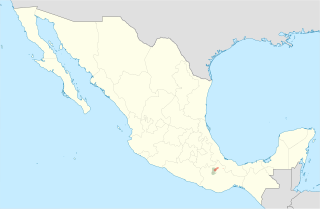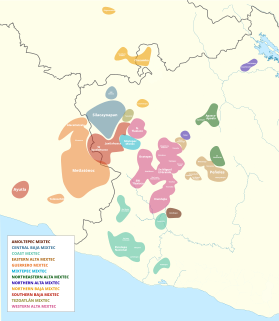
Moctezuma I, also known as Moteuczomatzin Ilhuicamina, Huehuemoteuczoma or Montezuma I, was the second Aztec emperor and fifth king of Tenochtitlan. During his reign, the Aztec Empire was consolidated, major expansion was undertaken, and Tenochtitlan started becoming the dominant partner of the Aztec Triple Alliance. Often mistaken for his popular descendant, Moctezuma II, Moctezuma I greatly contributed to the famed Aztec Empire that thrived until Spanish arrival, and he ruled over a period of peace from 1440 to 1453. Moctezuma brought social, economical, and political reform to strengthen Aztec rule, and Tenochititlan benefited from relations with other cities.

The Mixtecs, or Mixtecos, are indigenous Mesoamerican peoples of Mexico inhabiting the region known as La Mixteca of Oaxaca and Puebla as well as La Montaña Region and Costa Chica Regions of the state of Guerrero. The Mixtec Culture was the main Mixtex civilization, which lasted from around 1500 BC until being conquered by the Spanish in 1523.
Ndaxagua, locally known in Spanish as El Puente Colosal is a natural cave with double entrance and archaeological site, located in the extreme northern end of the Coixtlahuaca Basin, central-southern Mexico. The cave was most likely used by Mesoamerican cultures such as the Zapotec and Mixtec as well.

The Aztecs were a Pre-Columbian Mesoamerican people of central Mexico in the 14th, 15th, and 16th centuries. They called themselves Mēxihcah.

The Mixtec languages belong to the Mixtecan group of the Oto-Manguean language family. Mixtec is spoken in Mexico and is closely related to Trique and Cuicatec. The varieties of Mixtec are spoken by over half a million people. Identifying how many Mixtec languages there are in this complex dialect continuum poses challenges at the level of linguistic theory. Depending on the criteria for distinguishing dialects from languages, there may be as few as a dozen or as many as fifty-three Mixtec languages.

The altepetl was the local, ethnically-based political entity, usually translated into English as "city-state," of pre-Columbian Nahuatl-speaking societies in the Americas. The altepetl was constituted of smaller units known as calpolli and was typically led by a single dynastic ruler known as a tlatoani, although examples of shared rule between up to five rulers are known. Each altepetl had its own jurisdiction, origin story, and served as the center of Indigenous identity. Residents referred to themselves by the name of their altepetl rather than, for instance, as "Mexicas." "Altepetl" was a polyvalent term rooting the social and political order in the creative powers of a sacred mountain that contained the ancestors, seeds and life-giving forces of the community. The word is a combination of the Nahuatl words ātl and tepētl. A characteristic Nahua mode was to imagine the totality of the people of a region or of the world as a collection of altepetl units and to speak of them on those terms. The concept is comparable to Maya cah and Mixtec ñuu. Altepeme formed a vast complex network which predated and outlasted larger empires, such as the Aztec and Tarascan state.
Acatlán de Osorio is a city in the Mexican state of Puebla. The shortened name Acatlán, is commonly used to refer to the municipality of which it is the seat, and to the city itself. It is at an elevation of 1,213 m (3,981 ft). In the 2000 census the population of the city was 34,765.

Cuicatec is an Oto-Manguean language spoken in Oaxaca, Mexico. It belongs to the Mixtecan branch together with the Mixtec languages and the Trique language. The Ethnologue lists two major dialects of Cuicatec: Tepeuxila Cuicatec and Teutila Cuicatec. Like other Oto-Manguean languages, Cuicatec is tonal.

XEZV-AM is an indigenous community radio station that broadcasts in Spanish, Nahuatl, Mixtec and Tlapanec from Tlapa de Comonfort in the Mexican state of Guerrero. It is run by the Cultural Indigenist Broadcasting System (SRCI) of the National Commission for the Development of Indigenous Peoples (CDI). Launched on 10 May 1979, it was the first of the SRCI's radio stations in operation.

Tlapa de Comonfort, often shortened to Tlapa and known as Tinda'i in Mixtec, is a city in the mountain region of the Mexican state of Guerrero. It also serves as the municipal seat for the surrounding municipality of the same name.
The Chochos are an indigenous people of the Mexican state of Oaxaca.
San Juan Bautista Coixtlahuaca is a small town and municipality located in the Mixteca Region of the State of Oaxaca, Mexico, and the center of the Coixtlahuaca district. The name, "Coixtlahuaca" means 'plain of snakes' in the Nahuatl language.
Santiago Apoala is a village and municipality in the state of Oaxaca, Mexico, located north of Oaxaca city. It is part of the Nochixtlán District in the southeast of the Mixteca Region.

Coixtlahuaca was a pre-Columbian Mesoamerican state in the Mixteca Alta. Coixtlahuaca was a multi-ethnic polity, inhabited by both Chochos and Mixtecs. In addition to the Chocho and Mixtec languages, Nahuatl was used as a lingua franca. Its name means "plain of snakes". The state also exerted power over the Cuicatecans.

The Codex Sierra is a colonial Mesoamerican account book from Santa Catalina Texupa, covering the years from 1550 to 1564. It uses both alphabetic and pictorial modes of writing. Though Texupa is a Mixtec and Chocho community, the text is written in Nahuatl, albeit with some Mixtec words. The pictorial portion likewise uses Mixtec conventions, such as the "A-O" year sign.
Ayutla de los Libres is a city and seat of the municipality of Ayutla de los Libres, in the state of Guerrero, southern Mexico. As of 2010, its population was 15,370. The city of Ayulta de los Libres is the most populous in its municipality and accounts for about a quarter of the municipality's population.

Tulcingo (municipality) is a town and municipality in Puebla in south-eastern Mexico.

The Mixteca Region is a region in the state of Oaxaca, Mexico, part of the broader La Mixteca area which covers parts of the states of Puebla, Guerrero and Oaxaca. The region includes the districts of Juxtlahuaca, Silacayoapam, Huajuapan, Coixtlahuaca, Teposcolula, Tlaxiaco and Nochixtlán. The largest cities are Huajuapan and Tlaxiaco. According to the 1990 census the region had 556,256 people over the age of five, of which 227,680 spoke Mixteco.

The Indigenous people of Oaxaca are descendants of the inhabitants of what is now the state of Oaxaca, Mexico who were present before the Spanish invasion. Several cultures flourished in the ancient region of Oaxaca from as far back as 2000 BC, of whom the Zapotecs and Mixtecs were perhaps the most advanced, with complex social organization and sophisticated arts.

The internal classification of Mixtec is controversial. Many varieties are mutually unintelligible and by that criterion separate languages. In the 16th century, Spanish authorities recognized half a dozen lenguas comprising the Mixtec lengua. It is not clear to what extent these were distinct languages at the time. Regardless, the colonial disintegration of the Mixtec nation and resulting isolation of local communities led to the rapid diversification of local dialects into distinct languages. Below are some attempts at Mixtec classification by various scholars.














